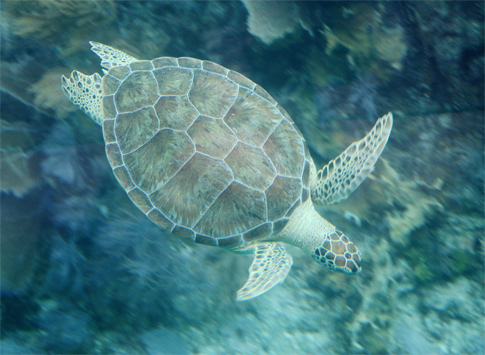¿Why We Use TRIMIX??
TRIMIX,
that "new" gas becoming available to divers made of Nitrogen,
Oxygen
and Helium,
is the gas we select for our deeper dives, whether they are
wrecks, open water or walls. Notice the quotation marks
around the word "new"?
That is because Heliumhas
been used for diving operations since early this century ... even
way before SCUBA became popular. It has been used since the first
half of the century in commercial, scientific and military
operations (just like Nitrox was)
with an outstanding and enviable safety record. Why
is this so ?
Because of the increase in safety it provides the diver FAR
outweighs any particular setback it might have. TRIMIX
has stopped being exclusive of extremely deep dives and has
become the choice for even those dives just within the
recreational "limit". We use TRIMIX
for any dive deeper than 130 ft (and some of us, even
shallower than that).
First,
and more importantly, it decreases inert gas narcosis to an
acceptable level which is selected by the individual divers.
This, by itself, more than suffices as a reason to dive it.
A well-trained diver with a clear head is able to cope with most
adversities that might be foreseen happening in a dive of this
nature. On the contrary, the best trained diver would be a
prime candidate for an accident (which at these depths has
proven to be fatal) when they become mentally impaired by inert
gas narcosis. How many HORROR stories have you heard from
deep divers ... if they can remember anything that happened at all??
With TRIMIX,
the diver would select what (equivalent) nitrogen depth s/he
wants, according to his/her own previous experience and
ability to focus under such influence. So, a diver could be
diving at 160 ft, but have the nitrogen level equivalent to,
let's say, 100 ft ... which is an acceptable level of
impairment. Besides, using TRIMIX,
they will be able to accomplish what their dive goals might have
been and REMEMBER what they saw, did or didn't do at
that depth. That clear head is CRITICAL when the margin for
errors is as thin as the skin of your teeth.
Second,
it now allows the diver to select his/her level of Oxygen partial
pressure without having to trade with Nitrogen pressure. As
depth increases we want to decrease our partial pressure of Oxygen to
a safe level to avoid the dreaded Ox-Tox.
With Nitrox,
the only exchange is to increase the Nitrogen fraction,
hence, its partial pressure (and associated narcosis). With TRIMIX,
we are able to maintain a low PPO2
while maintaining a desired PPN2
by offsetting the lower Oxygen level
with a higher Helium fraction.
Now the diver has a controlled PPO2
AND a controlled PPN2 ...
which are two of the divers' main concerns for this kind of
immersions.

Third,
the addition of a 'light" gas like Helium decreases
the overall density of the breathing gas, making it easier to
breathe at depth. When the gas density increases due to the
increased pressure, the regulator efficiency becomes an
important issue. Using a mixture which is less dense by the
addition of Helium decreases
gas viscocity, facilitating the breathing process which in turn
decreases the bodily retention of another gas of concern, Carbon
Dioxide (CO2).
CO2 retention
has been known to be a factor in increasing the propensity for Ox-Tox,
Bends and Nitrogen Narcosis.
So, by improving the breathing efficiency with the addition of Helium,
we avoid CO2buildup
and hence, the probability of the mentioned maladies.
|




There are a few setbacks with the use of Helium in
our mixes. The most important is that (depending on the dive
time) it increases our Deco
and starts with deeper stops (30 or 40 ft). Since most of the
time we are doing some kind of Deco anyway, this addition of a
few minutes might not be to much of a concern to us. But it does
add to the overall dive plan since we must determine how much gas
and at what percentages of Oxygen we
are Decoing.
A second concern about the use of Helium is
its cost. It increases the cost of the tankfill significantly.
Unfortunately, there is little we can do about this except pay.
But, when my life is at stake, I'd rather pay a little more
and be MUCH safer than save a few dollars and increase
my risks substantially. Would you save a dollar to rent a
parachute without an emergency chute or would you pay extra
for such a life-saving device?
Another item to consider is the
fact that the training you get to be able to use TRIMIX is
so intense and complete that you will use all the dive
planning knowledge to do your regular simpler dives to the point
of making them easier, more comfortable and safer.
You will have a more
complete picture of how your body performs and behaves under
such pressures and conditions. You will have a more
comprehensive knowledge of what gear is used for what type of dive
and WHY.
This new awareness will definitely sharpen your dive skills,
specially in dive planning.
WE HAVE IT !!
WE USE IT !!
WE TEACH IT !!
If you are looking for a solid TRIMIX
education to be a better and safer diver, or upgrade your
present NITROX
level, Advance your knowledge while increasing your safety and
enjoyment ... Get better preparation and practice ... Give
the Accomplices a call for the next scheduled course or for
one of our fantastic liveaboard trips ... SAFE ENJOYMENT WHILE YOU
LEARN !!!
SEND E-MAIL TO Wally
|